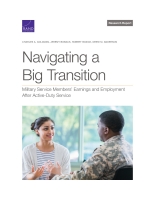Improving enlisted service member transitions from active duty to civilian life calls for better information about how service members fare in their transitions. The authors examined the relationship among enlisted service members' military occupations, personal characteristics, and civilian employment outcomes over the first three years after separation from active duty. They used detailed empirical analysis of more than 1 million service records, matched to employment and earnings after separation. The data encompass all separations from the armed forces from 2002 through 2010.
Earnings varied markedly in relation to the former service member's military occupation. Individuals who worked in intelligence and information systems consistently appeared in the high tier of post-service earnings. Those who worked in combat arms, medical, supply, and transportation were generally in the moderate or low tier of post-service earnings. These gaps point to military occupations that might need additional support to develop marketable skills, either during the whole of service members' military careers or around the time of transition.
Higher levels of education achieved at the time of separation were associated with greater earnings after separation. Separations after poor conduct or substance abuse were associated with lower earnings. Deployment during service had mixed association with post-service earnings, depending on service, gender, and length of service.
Service members in most military occupations had lower earnings after leaving the service compared with their final year of active duty. This finding emphasizes the importance of building marketable skills for service members and supporting their transitions into the civilian labor force.
PDF file 1.5 MB

No comments:
Post a Comment